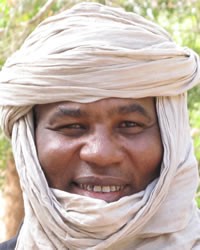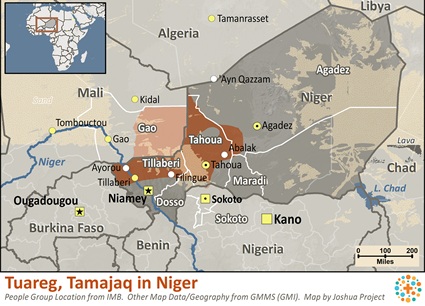The Tuareg peoples live in an area that stretches from the western Sahara to western Sudan. Tuareg are divided into several main political groups or tribal units. The Iwellemiden are a subgroup of the Kel Tamajaq (Tuaregs). The Western Iwellemiden live more in eastern Mali, and the Eastern Iwellemiden consider the town of Tchin-Tabaraden in the Region of Tahoua to be their cultural center. The name Tahoua Tuareg is often used for the Eastern Iwellemiden because of their location in the Tahoua Region
Their distinguishing characteristics include the unity of their language, their alphabet and their complex social organization.
Although the origin and early history of the Tuareg peoples are uncertain, these nomads appear to have traveled down from North Africa in a series of migrations as early as the seventh century. By the end of the 1300s, Tuareg tribes had established themselves as far south as the Nigerian border. At that time salt, gold, ivory, and slave markets sprang up across Tuareg territory, which stretched across North Africa, Europe, and the Middle East. Tuaregs became well known as stock raisers and merchants in the Saharan and Sahelian regions.
In 1972, the worst drought in 50 years struck the Sahara, bringing disaster and severe stress to the Tuareg peoples. Tuareg nomads were forced to travel southward with their families in search of pastures for their herds. This massive migration intensified as water supplies began to fail. Conflicts over rights and obligations among the people and governments of the regions were also generated. Many animals died of thirst, hunger or fatigue during the long journey. Thousands of Tuaregs drifted to the cities where they set up cowhide shelters and lean-to shanties on the fringes of town.
Although the rains in 1974 were good, they did not wash away the serious economic and social effects of the drought, and life for Tuaregs was never to be the same. Many Tuaregs, tempted by the less rigorous urban lifestyle, never returned to their original homeland.
Even today, the Tuaregs depend on their animals for survival; however, meat and milk are not enough, especially during the dry years. The basic elements of the Tuareg diet are milk, grains, and dates. Fresh vegetables are rarely eaten. Millet is raised both in the Saharan oases and in Sudan. Though meat is highly preferred, it is not eaten on a regular basis. Goat is the most commonly eaten meat; camel is rarely eaten.
Tuareg nomads live in small, lightweight leather tents or grass huts. A tent is usually about 10 feet long and 10 to 15 feet wide. A household can pack its goods on the backs of two camels, while one or two donkeys carry their odds and ends.
Tuaregs wear clothing that is loose and lightweight. In direct contrast to Arab custom, all of the men wear veils called tidjelmousts; the women do not wear veils. The most preferred tidjelmousts are dyed indigo, though many men wear black. To show respect, the men always cover their mouths, noses, and foreheads while in the presence of foreigners or their in-laws.
Though the Tamajaq Tuareg are virtually all Sunni Muslim, they have a reputation among other Muslims for being lukewarm in their faith. They practice a passive form of Islam, infused with folk beliefs and magic. Most do not even celebrate the most important Muslim fast of Ramadan.
There are few known Tamajaq Tuareg believers in Niger. Prayer is the key to reaching the Tuareg with the Gospel of Jesus Christ.
Pray that missions agencies and churches will accept the challenge of adopting and reaching the Tamajaq Tuaregs.
Pray that gospel broadcasts will soon be produced in the Tawallammat Tamajaq language.
Pray that God will grant wisdom and favor to mission agencies focusing on the Tuareg peoples in Niger.
Ask the Lord to save key leaders among the Tamajaq Tuareg who will boldly declare the gospel.
Ask the Lord to raise up strong local churches among the Tamajaq Tuaregs.
Scripture Prayers for the Tuareg, Tamajaq in Niger.
https://en.wikipedia.org/wiki/Tuareg_people
https://www.newworldencyclopedia.org/entry/Tuareg
| Profile Source: Joshua Project |

























